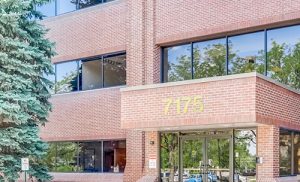 Over 30 percent of all office buildings in the Denver Metro market were built before 1989. These buildings, now well into their 30s, are just not as shiny and sprite as they used to be, and their tenants are attracted to the more contemporary buildings. Tired of being upstaged by the younger generation of architecture, what’s a 30-something building to do? Buy a new Corvette? It’s a real mid-life crisis. Like many of us who have celebrated the Big 3-0 (some many years ago), how do we age gracefully? Do we get a makeover, go to the gym, eat more vegetables?
Over 30 percent of all office buildings in the Denver Metro market were built before 1989. These buildings, now well into their 30s, are just not as shiny and sprite as they used to be, and their tenants are attracted to the more contemporary buildings. Tired of being upstaged by the younger generation of architecture, what’s a 30-something building to do? Buy a new Corvette? It’s a real mid-life crisis. Like many of us who have celebrated the Big 3-0 (some many years ago), how do we age gracefully? Do we get a makeover, go to the gym, eat more vegetables?
The hunter-green-and-pink bathrooms, the wood décor, and the huge lobbies are no longer chic. And the brass “accessories” look dated. These “millennial” buildings are sporting things like more efficient floor plans, energy-efficient lights, modern, sleek lobbies, better control systems and more amenities. For the 30 Somethings to be competitive, they need to focus on three key areas; design trends, upgrading aging building systems and sustainability practices.
A New Wave of Design Upgrades
Small changes in a building’s style and design can go a long way in looking more youthful, particularly in lobbies. As the lobby is the face of the interior of a building, an outdated-looking lobby is a hard impression to overcome. Brass, wood and bold pastels have given way to stainless steel, clean lines, lighter color palettes and more intimate lobbies. Even something as simple as new furniture can create a modern and current feel to an office building. Changing building directories to touch-screen monitors and updating tenant and building signage are relatively inexpensive and effective upgrades.
Restrooms can be another cost-effective face lift. Replacing 80s-era pastels, tile counters and brass trim with contemporary color palettes, stone counters, and touch-free faucets and soap dispensers, can easily modernize their look, while changing out toilet flush valves combined with low-flow technology can help minimize water waste.
HVAC & Lighting Improvements Offer a New Lease on Life
The biggest challenge 30 Somethings have to face is aging building systems, which eventually show the aches and pains of wear and tear. The biggest issue is HVAC systems, followed closely by roofs, boilers, elevators, plumbing, windows and parking lots.
The useful life of HVAC systems range from 15-25 years, depending on the type of system and the quality of the maintenance. HVAC systems are the second largest energy consumers in office buildings, after lighting. Modern HVAC systems are far more energy-efficient than their older counterparts. New systems are also much less harmful to the environment through the use of new, EPA-required refrigerants.
Building Automation Systems (BAS), also known as Energy Management Systems, control the building components as a part of an integrated system, and have improved dramatically along with the growth of computer technologies. Gone are the “dual floppy disc” operating systems, replaced by cloud-based computing, with remote monitoring and control capabilities. Building Automation Systems can now manage everything from lighting, heating, cooling, ventilation, and even building access. A well-designed, integrated BAS can reduce energy consumption up to 30%. In most Denver-area office buildings, this can equal a fifty-cent per square foot reduction in operating expenses.
Lighting control technology has also advanced tremendously since the days of big shoulder pads and poufy hair. Lighting typically uses around 40% of a building’s total energy consumption. The advent of LED technology, automatic dimming, electronic ballasts and occupancy sensors all reduce energy consumption.
The Sustainability Playlist
Sustainability is big with the New Kids on the Block. LEED and Green Buildings are more desirable in the market. In addition to energy efficiency improvements, there are some simple ways to integrate sustainable practices into daily property management, and increase your “cool” factor. “Green Seal” janitorial products contain far fewer harmful chemicals and use paper product standards such as chlorine-free paper production, biodegradability requirements and use of recycled content. Offering recycling services can also generate environmental benefits at a relatively low cost. Property managers certified through LEED are more able to identify opportunities to reduce the environmental impact of an office building.
Financing Your Building’s Comeback
Like a Little Red Corvette, mid-life crises are not cheap. But what is the cost of doing nothing? If not properly maintained, buildings may become obsolete in the market and lead to a “Flight to Quality,” resulting in lower occupancy, reduced lease rates and decreasing asset value.
What are the benefits of updating and upgrading a building? First and foremost, you have to stay in the game. You want to attract the strongest and best paying tenants. You can’t do that by looking old and run down. Building upgrades and modernization can, and usually will, result in more energy-efficient operations, lower operating expenses and better operating buildings.
Now the biggest challenge: How do you pay for all this? Junk bonds are out. Traditional bank loans are available, but there is a new loan program in Colorado that can make building upgrades almost entirely cost-free. C-PACE is a Colorado State program that finances energy-efficiency upgrades for commercial properties through loans paid for by a new mill levy on the property. The increase in property taxes is offset by the reduction in energy costs; sometimes the result is a net decrease in operating expenses. The improvements are financed 100% and the debt does not add to the individual property’s balance sheet. Depending on the lease types, these upgrades can be paid by the tenants through CAM charges. In our opinion, this is the best approach to finance those desperately-needed upgrades to stay competitive in the market.
30-Something buildings face many challenges against their younger counterparts. Staying abreast of current styles, upgrading to energy-efficient building systems and embracing sustainability will keep the older (and wiser) buildings hip and in the game for decades, just like U2 or Bon Jovi.
For more information on how your older office building can benefit from a makeover by Wheelhouse Commercial’s LEED-certified property managers, please contact us at: mkennedy@wheelhousecommercial.com.
Mark W. Kennedy is the President of Wheelhouse Commercial in Denver, Colorado. For more information about how Wheelhouse Commercial can help manage your properties, please call 303.518.7406 or email info@wheelhousecommercial.com.
is the President of Wheelhouse Commercial in Denver, Colorado. For more information about how Wheelhouse Commercial can help manage your properties, please call 303.518.7406 or email info@wheelhousecommercial.com.

